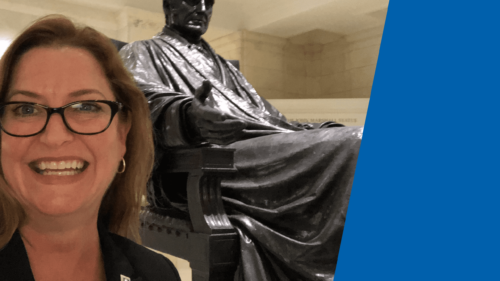
Teacher of the Year Takes on New Challenge: the Hybrid, Synchronous Classroom
As the 2020 school year begins in Florida, a months-long pandemic continues, putting new demands on teachers. Jennifer Jolley has spent the summer rethinking her lesson plans so as to meet the challenge. Yet she admits to feeling like a first-timer.
She has dedicated 27 years to her profession, and was just named 2020 Florida Social Studies Teacher of the Year by the Gilder Lehrman Foundation. Resourceful and adaptable, she has taught social studies in a variety of school settings. She spent seven years as a middle school teacher, including three years overseas, before moving to high school social studies. Today she teaches government (honors and regular) and AP courses in both US and comparative government at Palm Bay Magnet High School in Melbourne.
She has never stopped learning both on and off the job. Awarded a Madison Foundation Fellowship to pursue a Master’s degree, she earned it in Ashland University’s American History and Government program. Later, she spent a summer in Florida Senator Bill Nelson’s office as a Madison Foundation Congressional Fellow, gaining insights into the functions of Congress. In the summer of 2019, she was named Summer Institute Coordinator for the Madison Foundation. Spending summers at the institute, she will renew her understanding of our Constitutional system while troubleshooting the logistical issues of new fellows.
Through these programs and other teacher institutes, she’s gained a network of colleagues with whom she constantly shares pedagogical ideas.
Still, this fall, Jolley and her colleagues must master an entirely new instructional model: a “hybrid” system in which in-person and online teaching occur synchronously.
The Challenge of Hybrid, Synchronous Learning
To accommodate students who feel returning to campus is unsafe, teachers will open “a Google or Zoom meet during each class period, communicating with students at home while we teach those in front of us.” At the same time, “we’re switching to a block schedule, with 90-minute, instead of 45-minute, class periods. It does mean we’ll have fewer students each day”—a moderate safety measure during a pandemic. Jolley will now teach her semester-long courses in 9-week sessions. But with 300 students to teach this year, she’ll still see 75 students daily. Meanwhile, two days’ lessons must fit into one, giving students less time to process new concepts. “That’s a major paradigm shift.”
Read more at Meet Our Teacher Partners.

